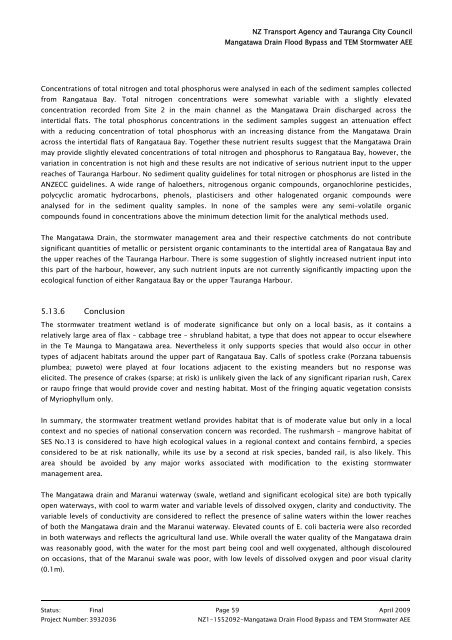2. Mangatawa catchment consents for earthworks, storm water ...
2. Mangatawa catchment consents for earthworks, storm water ...
2. Mangatawa catchment consents for earthworks, storm water ...
- No tags were found...
Create successful ePaper yourself
Turn your PDF publications into a flip-book with our unique Google optimized e-Paper software.
NZ Transport Agency and Tauranga City Council<br />
<strong>Mangatawa</strong> Drain Flood Bypass and TEM Storm<strong>water</strong> AEE<br />
Concentrations of total nitrogen and total phosphorus were analysed in each of the sediment samples collected<br />
from Rangataua Bay. Total nitrogen concentrations were somewhat variable with a slightly elevated<br />
concentration recorded from Site 2 in the main channel as the <strong>Mangatawa</strong> Drain discharged across the<br />
intertidal flats. The total phosphorus concentrations in the sediment samples suggest an attenuation effect<br />
with a reducing concentration of total phosphorus with an increasing distance from the <strong>Mangatawa</strong> Drain<br />
across the intertidal flats of Rangataua Bay. Together these nutrient results suggest that the <strong>Mangatawa</strong> Drain<br />
may provide slightly elevated concentrations of total nitrogen and phosphorus to Rangataua Bay, however, the<br />
variation in concentration is not high and these results are not indicative of serious nutrient input to the upper<br />
reaches of Tauranga Harbour. No sediment quality guidelines <strong>for</strong> total nitrogen or phosphorus are listed in the<br />
ANZECC guidelines. A wide range of haloethers, nitrogenous organic compounds, organochlorine pesticides,<br />
polycyclic aromatic hydrocarbons, phenols, plasticisers and other halogenated organic compounds were<br />
analysed <strong>for</strong> in the sediment quality samples. In none of the samples were any semi-volatile organic<br />
compounds found in concentrations above the minimum detection limit <strong>for</strong> the analytical methods used.<br />
The <strong>Mangatawa</strong> Drain, the <strong>storm</strong><strong>water</strong> management area and their respective <strong>catchment</strong>s do not contribute<br />
significant quantities of metallic or persistent organic contaminants to the intertidal area of Rangataua Bay and<br />
the upper reaches of the Tauranga Harbour. There is some suggestion of slightly increased nutrient input into<br />
this part of the harbour, however, any such nutrient inputs are not currently significantly impacting upon the<br />
ecological function of either Rangataua Bay or the upper Tauranga Harbour.<br />
5.13.6 Conclusion<br />
The <strong>storm</strong><strong>water</strong> treatment wetland is of moderate significance but only on a local basis, as it contains a<br />
relatively large area of flax – cabbage tree – shrubland habitat, a type that does not appear to occur elsewhere<br />
in the Te Maunga to <strong>Mangatawa</strong> area. Nevertheless it only supports species that would also occur in other<br />
types of adjacent habitats around the upper part of Rangataua Bay. Calls of spotless crake (Porzana tabuensis<br />
plumbea; puweto) were played at four locations adjacent to the existing meanders but no response was<br />
elicited. The presence of crakes (sparse; at risk) is unlikely given the lack of any significant riparian rush, Carex<br />
or raupo fringe that would provide cover and nesting habitat. Most of the fringing aquatic vegetation consists<br />
of Myriophyllum only.<br />
In summary, the <strong>storm</strong><strong>water</strong> treatment wetland provides habitat that is of moderate value but only in a local<br />
context and no species of national conservation concern was recorded. The rushmarsh – mangrove habitat of<br />
SES No.13 is considered to have high ecological values in a regional context and contains fernbird, a species<br />
considered to be at risk nationally, while its use by a second at risk species, banded rail, is also likely. This<br />
area should be avoided by any major works associated with modification to the existing <strong>storm</strong><strong>water</strong><br />
management area.<br />
The <strong>Mangatawa</strong> drain and Maranui <strong>water</strong>way (swale, wetland and significant ecological site) are both typically<br />
open <strong>water</strong>ways, with cool to warm <strong>water</strong> and variable levels of dissolved oxygen, clarity and conductivity. The<br />
variable levels of conductivity are considered to reflect the presence of saline <strong>water</strong>s within the lower reaches<br />
of both the <strong>Mangatawa</strong> drain and the Maranui <strong>water</strong>way. Elevated counts of E. coli bacteria were also recorded<br />
in both <strong>water</strong>ways and reflects the agricultural land use. While overall the <strong>water</strong> quality of the <strong>Mangatawa</strong> drain<br />
was reasonably good, with the <strong>water</strong> <strong>for</strong> the most part being cool and well oxygenated, although discoloured<br />
on occasions, that of the Maranui swale was poor, with low levels of dissolved oxygen and poor visual clarity<br />
(0.1m).<br />
Status: Final Page 59 April 2009<br />
Project Number: 3932036<br />
NZ1-1552092-<strong>Mangatawa</strong> Drain Flood Bypass and TEM Storm<strong>water</strong> AEE
















